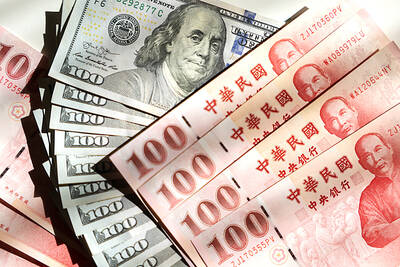US companies in China are seeing record-low profits, with business confidence at an all-time low amid US-China tensions and a slowing Chinese economy, a report published yesterday by a US business group said.
Out of 306 companies polled, a record-low 66 percent were profitable last year, the China business report published by the American Chamber of Commerce (AmCham) in Shanghai said.
The report also found that only 47 percent of respondents were optimistic about their business outlook in China over the next five years, the lowest in the survey’s history of more than two decades.

Photo: AP
Beijing and Washington have been at odds in the past few years over issues such as trade and manufacturing, as well as China’s claims over the South China Sea.
Beijing is also grappling with a slowing domestic economy, with lackluster consumer demand and deflationary pressures persisting even post-COVID-19 pandemic.
The geopolitical tensions between the two nations are the top challenge to businesses’ operations in China, the report found.
“It’s a balance between risk and reward,” AmCham Shanghai president Eric Zheng (鄭藝) told a news conference ahead of the report’s publication.
“The perceived risks of doing business in China have gone up in the past few years, but at the same time the market is slowing down, with soft demand and overcapacity,” he said.
Many businesses are now redirecting investments to other regions, such as Vietnam, Malaysia and South Asia, Zheng said.
A record high of 25 percent of companies polled reduced investment in China last year, AmCham’s report found, largely driven by concerns over China’s slowing growth.
While just over half of US companies expect their revenue to increase over last year, only 37 percent are expecting growth in China to outpace global growth in the coming three to five years.
Meanwhile, an intensification of tariffs this year by US President Joe Biden’s administration on Chinese goods has raised fears of a renewed trade dispute — a topic made more prominent ahead of November’s US presidential election.
“My view is that tariffs are going to stay in the game as a major trade policy toolbox,” AmCham Shanghai chairman Allan Gabor said at the news conference.
The scale and scope of potential additional tariffs from Washington hinge on the outcome of the election, he added.
However, regardless of who wins, “members have adjusted and are assuming that we’re going to have to work with that reality,” he said.
The AmCham report came a day after the EU Chamber of Commerce in China published a report with similar sentiments on the increasing risks of doing business in China.
The report highlighted a lack of implementation on promised reforms and an increasingly politicized business environment. It found that for some European firms, the risks of investing in China are beginning to outweigh the returns.
“We are concerned about there being a tipping point now, and therefore we have a call for action to the Chinese government to turn the tide,” European Chamber president Jens Eskelund told a news conference on Wednesday.
“China is becoming no longer a top priority, but increasingly a top three or top five destination,” he said. “We believe that the relative attractiveness as a location will continue to deteriorate unless we address some of these concerns.”
Additional reporting by AFP

MARKET LEADERSHIP: Investors are flocking to Nvidia, drawn by the company’s long-term fundamntals, dominant position in the AI sector, and pricing and margin power Two years after Nvidia Corp made history by becoming the first chipmaker to achieve a US$1 trillion market capitalization, an even more remarkable milestone is within its grasp: becoming the first company to reach US$4 trillion. After the emergence of China’s DeepSeek (深度求索) sent the stock plunging earlier this year and stoked concerns that outlays on artificial intelligence (AI) infrastructure were set to slow, Nvidia shares have rallied back to a record. The company’s biggest customers remain full steam ahead on spending, much of which is flowing to its computing systems. Microsoft Corp, Meta Platforms Inc, Amazon.com Inc and Alphabet Inc are

Luxury fashion powerhouse Prada SpA has acknowledged the ancient Indian roots of its new sandal design after the debut of the open-toe footwear sparked a furor among Indian artisans and politicians thousands of miles from the catwalk in Italy. Images from Prada’s fashion show in Milan last weekend showed models wearing leather sandals with a braided design that resembled handmade Kolhapuri slippers with designs dating back to the 12th century. A wave of criticism in the media and from lawmakers followed over the Italian brand’s lack of public acknowledgement of the Indian sandal design, which is named after a city in the

The US overtaking China as Taiwan’s top export destination could boost industrial development and wage growth, given the US is a high-income economy, an economist said yesterday. However, Taiwan still needs to diversify its export markets due to the unpredictability of US President Donald Trump’s administration, said Chiou Jiunn-rong (邱俊榮), an economics professor at National Central University. Taiwan’s exports soared to a record US$51.74 billion last month, driven by strong demand for artificial intelligence (AI) products and continued orders, with information and communication technology (ICT) and audio/video products leading all sectors. The US reclaimed its position as Taiwan’s top export market, accounting for

INVESTOR RESILIENCE? An analyst said that despite near-term pressures, foreign investors tend to view NT dollar strength as a positive signal for valuation multiples Morgan Stanley has flagged a potential 10 percent revenue decline for Taiwan’s tech hardware sector this year, as a sharp appreciation of the New Taiwan dollar begins to dent the earnings power of major exporters. In what appears to be the first such warning from a major foreign brokerage, the US investment bank said the currency’s strength — fueled by foreign capital inflows and expectations of US interest rate cuts — is compressing profit margins for manufacturers with heavy exposure to US dollar-denominated revenues. The local currency has surged about 10 percent against the greenback over the past quarter and yesterday breached